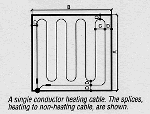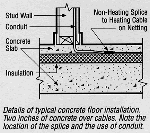

| Instructions for installing Electric Heating Cables | |
| Your electric heating cables are easily installed by following these instructions. Complete instructions are included with each cable. | |
| First mount the thermostat with the conduit drops as per the mounting requirements. |
| Secondly, lay and staple the diamond wire on the clean sub-floor. This should be tight to the floor. Locate the word SPLICE on the heating cable, seven feet from the end. The word SPLICE must be in the floor! Secure the heating wire at this point to the diamond wire using zip ties, rebar wire, or a suitable fastener. You are now ready to uncoil the electric heating wire and fasten the cable to the diamond wire in a serpentine fashion on the floor to be heated. Pay attention to the calculated spacing while working your way around the perimeter of the room. If your calculated spacing is six inches, stay three inches off the wall. |  detail |
| Now, work your way back to the thermostat location. Locate the word SPLICE on the other end and fasten this to the diamond wire in the open floor area. You now have two non-heating ends of the cable that will be carefully pushed up to the conduit to the electrical box, thermostat location. IF YOU HAVE LEFT OVER CABLE, adjust the spacing to use up the "extra" cable. |
| TEST the cable: each cable comes with instructions and a chart giving the ohms resistance for the cable you have purchased. Using a simple ohm meter, test the heating cable and compare it to the chart. This will indicate that the cable has not been damaged during the installation! The cable is now ready to be covered with dry pack, concrete, or a self-leveling compound |  detail |
| Before covering the cable, extend the sensor conduit between two runs
of cable and install the sensor in the conduit. The sensor is included with the thermostat. The sensor should be located in the "open"
floor area! Finally, make all the electrical connections to the thermostat and mount the thermostat to the electrical box. Remember, you are working with high voltage; if you are not comfortable with this, consult an electrician. |
 detail |